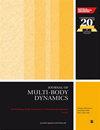曲轴系统多工况下刚柔耦合扭振分析及振动抑制
IF 1.9
4区 工程技术
Q3 ENGINEERING, MECHANICAL
Proceedings of the Institution of Mechanical Engineers Part K-Journal of Multi-Body Dynamics
Pub Date : 2023-10-23
DOI:10.1177/14644193231208532
引用次数: 0
摘要
随着中国页岩气资源的快速开发,对大型、多柱压缩机的需求不断增加。然而,这一发展也暴露了压缩机曲轴系统的扭振问题,特别是在可变负载和多种工作条件下。为了减小压气机曲轴的扭振,保证压缩机组安全稳定运行,本研究提出了一种考虑各部件柔性效应并考虑多种工况的页岩气压气机曲轴系统扭振计算与抑制方法。考虑主轴承、连杆和曲轴的柔性变形,重点分析了曲轴系统在多种工况下的刚柔耦合扭振特性。研究成功地确定了曲轴系统在7种典型工况下的扭振响应。针对最坏工况,对曲轴系统的振动响应进行了详细分析,并通过响应面优化设计对曲轴扭振进行了抑制研究。研究结果表明,压缩机系统在运行过程中存在低频振动。在第四柱曲柄销处测得的最大扭转角变形为0.052°。经过结构优化,在最恶劣工况下曲柄销的相对扭转角变形减小了25.61%。质心角速度峰值减小了22.17%。这些结果表明,该方法对压气机曲轴系统的扭转振动有显著的抑制作用,从而提高了工作安全性。本文章由计算机程序翻译,如有差异,请以英文原文为准。
Analysis of rigid-flexible coupled torsional vibration and vibration suppression of crankshaft system under multiple working conditions
With the rapid development of shale gas resources in China, there is an increasing demand for large and multiple column compressors. However, this development has brought to light the issue of torsional vibration in compressor crankshaft systems, particularly under variable loads and multiple working conditions. In order to reduce the torsional vibration of the compressor crankshaft and ensure the safe and stable operation of the compressor unit, this study proposes a method for calculating and suppressing torsional vibration in the crankshaft system of a shale gas compressor, which takes into account the flexibility effect of various parts and considers multiple working conditions. The analysis focused on the rigid-flexible coupling torsional vibration characteristics of the crankshaft system under multiple working conditions, considering the flexible deformation of the main bearing, connecting rod, and crankshaft. The study successfully determined the torsional vibration response of the crankshaft system under seven typical working conditions. Furthermore, for the worst conditions, a detailed analysis of the vibration response of the crankshaft system was conducted and carried out a study on suppressing crankshaft torsional vibration through response surface optimization design. The study findings indicate that the compressor system exhibits low-frequency vibrations during operation. The maximum torsional angular deformation at the crank pin of the fourth column is measured to be 0.052°. Following structural optimization, the relative torsional angular deformation of the crank pin is reduced by 25.61% under the worst operating conditions. Moreover, the peak angular velocity of the center of mass is reduced by 22.17%. These results demonstrate a significant suppression effect on torsional vibrations in the compressor crankshaft system, leading to improved working safety.
求助全文
通过发布文献求助,成功后即可免费获取论文全文。
去求助
来源期刊

CiteScore
4.10
自引率
11.10%
发文量
38
审稿时长
>12 weeks
期刊介绍:
The Journal of Multi-body Dynamics is a multi-disciplinary forum covering all aspects of mechanical design and dynamic analysis of multi-body systems. It is essential reading for academic and industrial research and development departments active in the mechanical design, monitoring and dynamic analysis of multi-body systems.
 求助内容:
求助内容: 应助结果提醒方式:
应助结果提醒方式:


